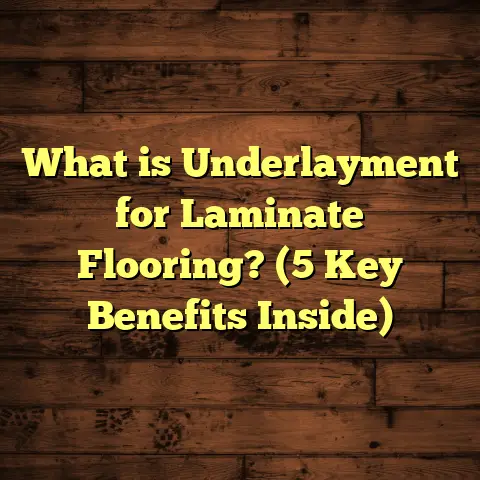What is In Situ Concrete Floor? (5 Key Benefits You Must Know)
What is In Situ Concrete Floor?
Let me start by breaking down the term so we’re both on the same page. In situ concrete floors are slabs of concrete that are poured and cured directly at the construction site. The phrase “in situ” means “on site” or “in place,” which perfectly describes how this flooring is made. Unlike pre-cast concrete panels or tiles manufactured off-site and transported to a building, in situ concrete floors are formed on location, shaped to fit the space exactly.
I remember my first encounter with in situ concrete flooring during a project renovation of an old warehouse. The building had oddly shaped rooms with lots of corners and curves that didn’t suit standard flooring panels. The contractor suggested pouring concrete directly on site. Watching them prepare the formwork, pour the wet concrete, and then smooth it out was fascinating. The result was a flawless, continuous surface that fit the building perfectly.
But beyond just being a slab of concrete, this type of flooring has evolved significantly with advances in technology and materials. These floors are no longer just basic grey surfaces—they can be customized, finished in many ways, and adapted for various uses, from industrial warehouses to elegant residential spaces.
Let’s explore what makes in situ concrete floors a compelling choice for many projects.
1. Durability that Lasts Decades
One of the key reasons I’ve championed in situ concrete floors throughout my career is their unmatched durability. You don’t need me to tell you that floors take a beating—whether it’s heavy machinery in a factory or kids running around at home. You want something that can hold up over time without constant repairs or replacements.
How tough are we talking?
Concrete is one of the strongest building materials available. When poured correctly, with proper reinforcement like steel bars or mesh embedded within, an in situ concrete slab can carry enormous loads and resist damage.
In fact, data from the American Concrete Institute shows:
- Concrete floors can support compressive strengths up to 4,000 psi (pounds per square inch) or higher.
- Properly cured concrete develops hardness and resistance that can last 50 years or more.
- Resistance to abrasion exceeds many other flooring materials, reducing wear in high-traffic areas.
My experience with durability
During a refurbishment project at a manufacturing plant, I oversaw the installation of an in situ concrete floor designed to support forklifts and heavy pallets moving daily. Over five years later, the floor had minimal cracks—mostly superficial hairline ones typical with concrete shrinkage—and no significant structural issues. The company saved thousands by avoiding frequent repairs common with epoxy coatings or tile floors.
Why does this matter?
Durability means fewer headaches and less money spent on fixing broken floors. It also means safety stays high since uneven or damaged floors can cause accidents.
2. Customization and Design Flexibility
People often ask me if concrete floors are boring or plain. I get it—concrete has a reputation for dull grey slabs. But in situ concrete floors offer so much more flexibility than you might think.
Because the concrete is poured on site, you can customize:
- Shape and size: Curves, slopes, steps, or unusual room shapes are easy to accommodate.
- Colors: Using stains or dyes during or after pouring can give you warm earth tones, vibrant hues, or anything in between.
- Textures: You can decide between smooth polished finishes, exposed aggregate (where the gravel shows), brushed surfaces for slip resistance, or stamped patterns that mimic tile or stone.
- Embedded features: Radiant heating pipes can be laid right into the slab before the concrete goes down to keep your floors warm in winter.
A personal story about design
A couple of years ago, I worked on a modern home where the owner wanted something unique for their open-plan living area. We ended up pouring an in situ concrete floor stained in rich terracotta tones with sweeping curves that flowed with the room’s architecture. Adding a polished finish gave it a subtle shine that caught natural light beautifully.
They told me afterward that they loved how the floor felt solid yet sophisticated—something they never imagined concrete could do.
Why does design flexibility matter?
Not every space is square or standard. If you want your floor to be part of the room’s personality rather than just something functional underfoot, in situ concrete gives you options most other materials can’t match.
3. Cost-Effectiveness Over Time
I won’t sugarcoat it: the upfront cost of an in situ concrete floor can be higher than some alternatives like vinyl tiles or carpet. But let me share why it’s often the best value over time.
The real cost story
Concrete floors don’t just save you money because they last long—they also reduce ongoing expenses related to maintenance and energy use.
Here’s what I’ve seen:
- Lower maintenance: Unlike wood, carpet, or laminate floors that need regular polishing, replacement, or special cleaners, sealed concrete needs very little beyond sweeping and occasional mopping.
- Energy savings: Concrete has excellent thermal mass. This means it absorbs heat during the day and slowly releases it at night, helping stabilize indoor temperatures. When paired with radiant heating systems embedded directly in the slab, this can cut heating bills by up to 25%, according to studies by the U.S. Department of Energy.
- Fewer replacements: A well-installed concrete floor can last for decades without needing replacement—saving you thousands compared to redoing carpets every few years.
Real numbers from my projects
For example, I was involved in a commercial office build where they considered laminate flooring versus in situ concrete. The laminate was cheaper upfront but required replacement every 7-10 years. Over 20 years, the total cost for laminate (including replacement and maintenance) was about 30% higher than sticking with concrete from day one.
So should you worry about initial costs?
If budget is tight, I suggest planning carefully with tools like FloorTally to get accurate estimates based on your location and project specifics. That way you can see long-term savings clearly and avoid surprises.
4. Environmentally Friendly Choice
More clients these days ask me about sustainable building choices. Concrete might not be the first material people think of when it comes to green construction—but in situ concrete floors have several environmental advantages.
How is concrete green?
- Many mixes now incorporate recycled materials like fly ash (a byproduct from power plants) or slag cement (from steel mills). This reduces reliance on raw cement production, cutting carbon emissions.
- Since it’s poured on site with precise measurements, material waste is minimal compared to pre-cast floors which might generate offcuts.
- Thermal mass properties reduce energy consumption by helping regulate indoor temperature naturally.
- Long lifespan means fewer resources spent on replacing flooring every few years.
A case study from my work
I consulted on a LEED-certified commercial building where using locally sourced materials and in situ concrete floors helped achieve energy efficiency credits. The client appreciated knowing their investment contributed to environmental goals without sacrificing performance or aesthetics.
What about disposal?
Unlike some synthetic flooring materials that end up in landfills quickly, old concrete can often be crushed and recycled as aggregate for new construction projects—closing the loop nicely.
5. Easy Maintenance and Cleaning
One of my favorite things about working with in situ concrete floors is how easy they are to keep clean. If you have pets or kids at home, this might be music to your ears.
Why are they so simple to maintain?
- Properly sealed concrete resists stains from spills like wine or oil—you just wipe them up.
- No grout lines mean no hidden dirt traps.
- Sweeping and damp mopping are usually all you need.
- No waxing or polishing required like wood floors.
In one residential project where the family had two energetic dogs, the owners commented on how much easier it was to clean their concrete floors compared to their previous hardwood—no scratches from claws and no water damage risks.
Data supports this too
According to research from the International Concrete Repair Institute:
- Sealed concrete floors reduce cleaning time by up to 40% compared to tile or wood.
- They also help improve indoor air quality since dust doesn’t accumulate easily.
Additional Insights: Installation Process and Considerations
Since I know many people wonder about what goes into installing an in situ concrete floor, here’s a quick overview from my experience.
Step-by-step installation
- Preparation: The sub-base is prepared and compacted thoroughly to provide a stable foundation.
- Formwork: Wooden or metal forms outline the edges of the slab.
- Reinforcement: Steel bars (rebar) or mesh are laid inside to strengthen the slab.
- Pouring: Concrete is delivered fresh and poured into place.
- Leveling and finishing: Skilled workers use screeds and trowels to level and smooth the surface.
- Curing: The slab must cure properly over days or weeks to reach full strength.
- Sealing: Once cured, sealing protects from stains and wear.
What could go wrong?
Poor installation can lead to cracking or uneven surfaces. That’s why having experienced contractors is crucial—a lesson I learned early on when I saw a project delayed due to rushed curing that caused surface damage.
How In Situ Concrete Floors Compare with Other Flooring Types
Sometimes people ask me how these floors stack up against options like hardwood, tile, vinyl, or carpet.
| Feature | In Situ Concrete | Hardwood | Tile | Vinyl | Carpet |
|---|---|---|---|---|---|
| Durability | Very high (50+ years) | Moderate (15-30 yrs) | High (20+ years) | Low-moderate | Low (5-10 years) |
| Maintenance | Low | Moderate-high | Moderate | Low | High |
| Cost (Long-term) | Low | Moderate-high | Moderate | Low | High |
| Customization | High | Moderate | Moderate | Moderate | High (colors/patterns) |
| Environmental Impact | Moderate-low | Variable | Moderate | High | High |
| Comfort (Warmth/Softness) | Low-medium | High | Low | Medium | High |
This table reflects general trends but individual project needs may vary greatly.
Final Thoughts from My Flooring Journey
I’ve installed countless floors over two decades—from rustic wooden planks to intricate tiles—but few materials have impressed me as much as in situ concrete floors for their combination of strength, flexibility, cost effectiveness, environmental friendliness, and ease of care.
If you’re considering your next flooring project—whether residential, commercial, or industrial—think about what you truly need: longevity? Style? Budget control? Eco-friendliness? Chances are good that an in situ concrete floor could fit perfectly.
And if you need help figuring out costs or design options tailored just for your space, I’m happy to guide you using tools like FloorTally that provide detailed local estimates based on real data.
Feel free to reach out anytime if you want tips on installation best practices or maintenance advice!





